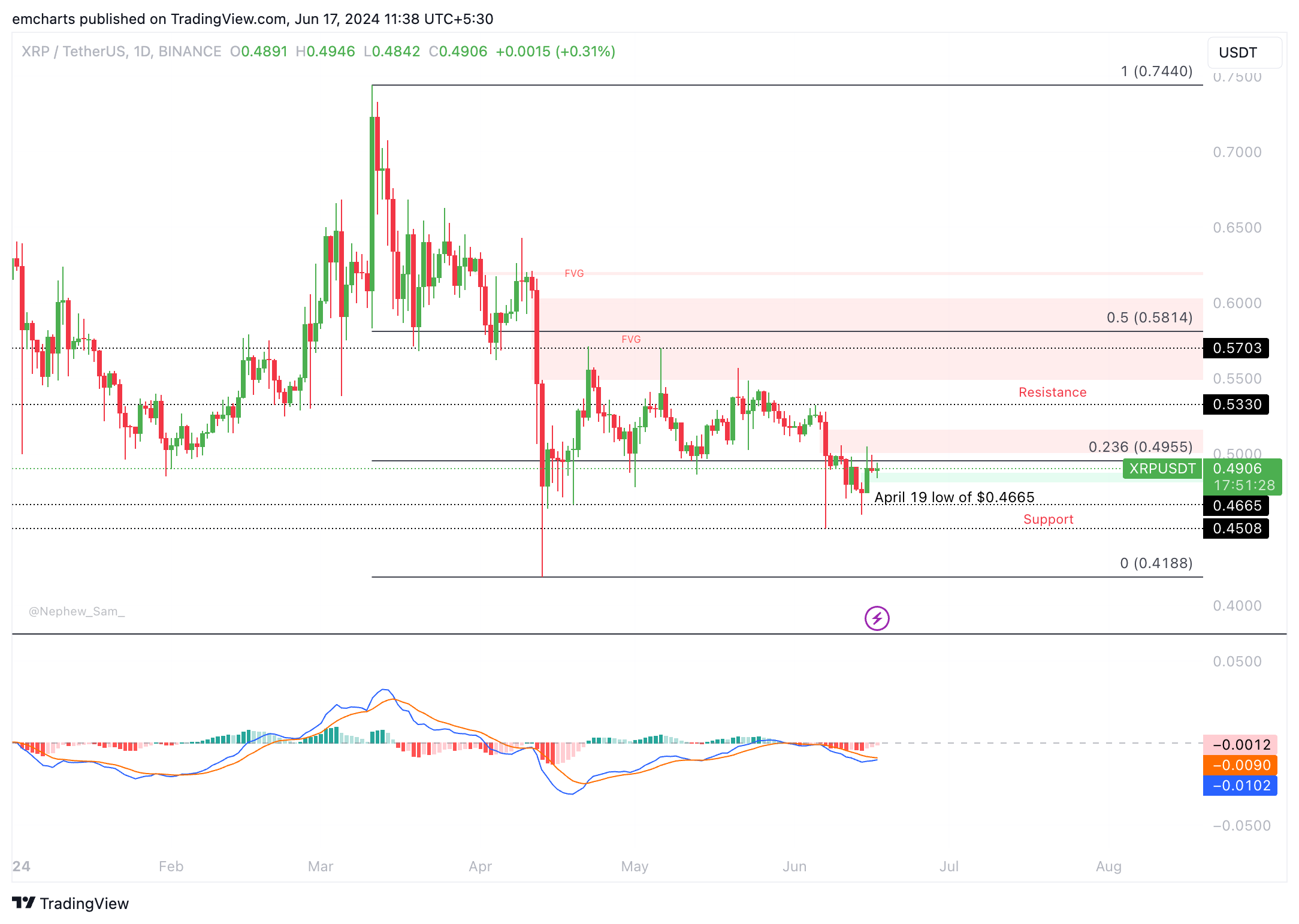XRP struggles for gains despite rising evidence that SEC abandoned demand for $2 billion fine
- Ripple Chief Legal Officer says that SEC seems to have abandoned its “absurd demand” of a $2 billion penalty.
- The SEC’s latest reply to the judge suggests a fine of around $100 million, above the $10 million ceiling that Ripple considers fair.
- XRP trades broadly steady on Monday, facing sticky resistance at $0.50.
XRP struggles to make a comeback above sticky resistance at $0.50 on Monday as traders continue to assess the legal skirmishes between blockchain firm Ripple and the US Securities and Exchange Commission (SEC).
Ripple’s lawyers have asked the judge to consider a civil penalty of around $10 million by drawing parallels with the recent settlement amount for Terraform Labs, another crypto firm embroiled in a legal battle with the SEC. The SEC responded to Ripple’s counter and quoted a $102.6 million figure instead, far lower than the previously requested $2 billion for allegedly violating securities laws.
Ripple’s Chief Legal Officer Stuart Alderoty said on Saturday that, by looking at the SEC’s counter letter to the judge, the regulator “seems to have abandoned its absurd demand for $2 billion.”
Daily digest market movers: Ripple CLO responds to SEC take on $2 billion fine
- The SEC vs. Ripple lawsuit has dragged on since 2020. The US financial regulator and the payment remittance firm are arguing on the fine to be paid for the alleged violation of securities laws, with the SEC asking for $2 billion in penalties and XRP for $10 million.
- In the most recent reply to Ripple’s letter, the US regulator has quoted $102.6 million by comparing the recent deal struck between the SEC and Terraform Labs. Still, about this figure, the SEC also said: “That low of a penalty would not satisfy the purposes of the civil penalty statutes,” signaling that it does not seem willing to accept a similar deal.
- Ripple’s CLO Stuart Alderoty commented on the SEC's reply letter and noted that the regulator seems to have abandoned the “absurd demand” for $2 billion.
The @SEC is raging. Ripple defended itself - “agreeing to nothing.” The court gave clarity that XRP is not a security. There are no “victims” to compensate. And worst of all for the @SEC, Ripple is thriving. But at least @SEC seems to have abandoned its absurd demand for $2B. https://t.co/KVSkB9OqlH
— Stuart Alderoty (@s_alderoty) June 15, 2024
- Alderoty comments on the SEC’s argument that “Ripple accepts nothing,” referring to the alleged securities violation. Ripple had drawn parallels between the SEC’s lawsuit against the firm and the one against Terraform Labs and its founders.
- The regulator pointed out that Terraform Labs went “out of business for good,” and several factors accounted for the fine, which was 1.27% of gross sales. According to the SEC, the same does not apply to Ripple, given the firm “accepts nothing,” meaning it does not recognize or acknowledge securities law violations.
#XRPCommunity #SECGov v. #Ripple #XRP @SECGov has responded to @Ripple’s letter regarding the TerraForm Labs Consent Judgment. pic.twitter.com/VvGSJffwa8
— James K. Filan (@FilanLaw) June 14, 2024
Technical analysis: XRP struggles to break sticky resistance at $0.50
Ripple wiped out nearly 2% of its value last week while attempting to recover from its decline on Monday. The altcoin hasn’t been able to break past resistance at $0.50, failing to close above this level nearly all days during last week.
XRP trades at $0.4905, inching closer to testing the $0.50 resistance on the daily time frame. The XRP/USDT chart below shows red histogram bars below the neutral line on the Moving Average Convergence Divergence (MACD) indicator, supporting the recent decline in Ripple’s token.
The MACD implies there is underlying negative momentum in Ripple’s price trend. If it corrects further, XRP could find support at the April 19 low of $0.4665.

XRP/USDT 1-day chart
If Ripple sees a daily candlestick close above $0.50, it could invalidate the bearish thesis. In this scenario, the next resistance is at the June 5 high of $0.5326.
Cryptocurrency metrics FAQs
The developer or creator of each cryptocurrency decides on the total number of tokens that can be minted or issued. Only a certain number of these assets can be minted by mining, staking or other mechanisms. This is defined by the algorithm of the underlying blockchain technology. Since its inception, a total of 19,445,656 BTCs have been mined, which is the circulating supply of Bitcoin. On the other hand, circulating supply can also be decreased via actions such as burning tokens, or mistakenly sending assets to addresses of other incompatible blockchains.
Market capitalization is the result of multiplying the circulating supply of a certain asset by the asset’s current market value. For Bitcoin, the market capitalization at the beginning of August 2023 is above $570 billion, which is the result of the more than 19 million BTC in circulation multiplied by the Bitcoin price around $29,600.
Trading volume refers to the total number of tokens for a specific asset that has been transacted or exchanged between buyers and sellers within set trading hours, for example, 24 hours. It is used to gauge market sentiment, this metric combines all volumes on centralized exchanges and decentralized exchanges. Increasing trading volume often denotes the demand for a certain asset as more people are buying and selling the cryptocurrency.
Funding rates are a concept designed to encourage traders to take positions and ensure perpetual contract prices match spot markets. It defines a mechanism by exchanges to ensure that future prices and index prices periodic payments regularly converge. When the funding rate is positive, the price of the perpetual contract is higher than the mark price. This means traders who are bullish and have opened long positions pay traders who are in short positions. On the other hand, a negative funding rate means perpetual prices are below the mark price, and hence traders with short positions pay traders who have opened long positions.

